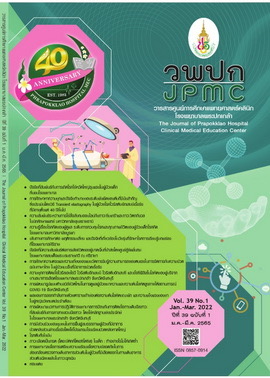Educational Pathways, Risk-Taking Behaviors, and Associated Factors of Adolescents with Specific Learning Disorder at Siriraj Hospital
Main Article Content
Abstract
BACKGROUND: Specific learning disorder (SLD) is a disorder due to abnormal brain function that impacts reading, writing, and calculation skills. Even though a child with SLD may have normal intelligence, their academic skill may be significantly below average. Untreated SLD patients face academic failure, increased risk-taking behaviors, and emotional problems.
OBJECTIVES: The purpose of the study was to investigate the educational pathways, risk-taking behaviors, and risk factors of adolescents with SLD.
METHODS: A retrospective chart review was conducted among 95 patients with SLD aged 15–18 years old who had graduated from 9th grade and were treated at Siriraj Hospital between January–December 2019, with data statistical analysis performed using the chi-squared test.
RESULTS: In total, 95 patients were included in the study, with 82 of them male (86.3%). The results showed that 58 patents (61.1%) went to high school, 30 patients (31.6%) went to vocational schools, and 7 patients (7.4%) had dropped out of school. The most common risk-taking behaviors included gaming (50.5%), school bullying (26.3%), and violence (12.6%). The factors that were significantly associated with the educational pathways (p<0.05) included depressive mood and receiving special education in both Thai and Mathematics.
CONCLUSIONS: Most of the SLD patients at Siriraj Hospital continue their education in high school. The most common risk-taking behaviors are gaming, school bullying, and violence. The factors that were significantly associated with the educational pathways included depressive mood and receiving special education in both Thai and Mathematics.
Thaiclinicaltrials.org number, TCTR 20211215003
Article Details

This work is licensed under a Creative Commons Attribution-NonCommercial-NoDerivatives 4.0 International License.
References
American Psychiatric Association. Diagnostic and statistical manual of mental disorders. 5th ed. American Psychiatric Association; 2013.
DuPaul GJ, Gormley MJ, Laracy SD. Comorbidity of LD and ADHD: implications ofDSM-5 for assessment and treatment. J Learn Disabil 2013;46:43-51.
Alesi M, Rappo G, Pepi A. Self-esteem at school and self-handicapping inchildhood: comparison of groups with learning disabilities. Psychol Rep 2012;111:952-62.
Grigorenko EL, Hart L, Hein S, Kovalenko J, Naumova OY. Improved educational achievement as a path to desistance. New Dir Child Adolesc Dev 2019;2019(165):111-35.
U.S. Department of Education. 38 th Annual report to congress on the implementation of the individuals with disabilities education act, 2016. Washington D.C.: Education Publications Center; 2016.
McFarland J, Cui J, Stark P. Trends in high school dropout and completion rates in the United States: 2014 . Washington, DC: National Center for Education Statistics; 2014.
Office of the Educational Council. Thailand’s Educational Statistics 2016-2017. [Internet] 2018 [cited 2021 July 24]. Available from http://backoffice.onec.go.th/uploads/Book/1634-file.pdf
Sangsupawanich P, Tantivess S, Tosanguan K, Pathanapasut C, Lekuathai W, Varachotkumjon J, et al. School-based screening for attention deficit and hyperactivity disorder (ADHD) and learning disorders (LD). Nunthaburi: Health Intervention and Technology Assessment Program; 2011.
Limsuwan N. School refusal in child and adolescent patients at Ramathibodi Hospital. J Psychiatr Assoc Thailand 2012;57:39-46.
Tomasini G, Martínez-Basurto L, LozadaGarcía R. Bridging the gap between theory and practice: ecological risk/resilience model contributions to special education. Creat Educ 2016;7:1093-110.
Bonti E, Giannoglou S, Georgitsi M, Sofologi M, Porfyri GN, Mousioni A, et al. Clinical profilesand socio-demographic characteristics of adults with specific learning disorderin northern greece. Brain Sci.[Internet] 2021[cited 2021 June 8];11(5):602. Available from: https://www.mdpi.com/2076-3425/11/5/602
Smart D, Youssef GJ, Sanson A, Prior M, Toumbourou JW, Olsson CA. Social mediators of relationships between childhood reading difficulties, behaviour problems, and secondary school noncompletion. Aust J Psychol 2019;71:171-82.
Yamane T. Statistics: an introductory analysis. 3rd ed. New York: Harper and Row ; 1973.
Channarong P, Vechvirool C, Wattasopon C. Manual of wechsler intelligence scale for children WISC-III, Thai edition. Bangkok: Beyond Publishing; 2004.
Hosiri T, Sumalrot T, Meechanphet V, Imaroonrak S, Auampradit N. Wechsler intelligence quotient profiles of childrenand adolescents with specific learning disorder. Thai J Clin Psychol 2020;51(2):1-12.
Horowitz SH, Rawe J, Whittaker MC. The state of learning disabilities: understanding the 1 in 5 [Internet]. National Center for Learning Disabilities; 2017 [cited 2021June 17].Available from https://www.ncld.org/research/state-of-learning-disabilities/executive-summary.
Pakkarana Ni, Sawangboon T. Factors affecting continuing to study in vocational education and guidelines on promoting the image of vocational education: mixed methods research. Journal of Educ Meas Mahasarakham Univ 2020;26(2):146-60.
Nuanpan C, Thitiluck S. Violence: the hegemony process of vocational students in Bangkok. Journalof Rangsit Graduate Studies in Business and Social Sciences 2020;ุ6(1):28-41.
Kazda L, Bell K, Thomas R, McGeechan K, Sims R, Barratt A.Overdiagnosis ofattention-deficit/hyperactivity disorder in children and adolescents: asystematic scoping review. JAMA Netw Open. [Internet] 2021[cited 2021 June 17];4(4):e215335. Available from: https://jamanetwork.com/journals/jamanetworkopen/fullarticle/2778451
Sahoo MK, Biswas H, Padhy SK. Psychological co-morbidity in children withspecific learning disorders. J Family Med Prim Care2015;4:21-5.
Heiman T, Olenik-Shemesh D. Social-emotional profile of children with andwithout learning disabilities: the relationships with perceived loneliness,self-efficacy and well-being. Int J Environ Res Public Health. [Internet] 2020[cited 2021 Mar 15];17(20):7358. Available from:https://www.mdpi.com/1660-4601/17/20/7358/htm
Arirochanakul T. Associated factor with decision not to train vocational study in secondary students in Chiangmai [dissertation].Chiangmai; 2015 [cited 2021 July 25]. Available from: http://www.payaptechno.ac.th/app/images/payap/vijai-2558/vijaistabun/vijaistabun-3.pdf.

